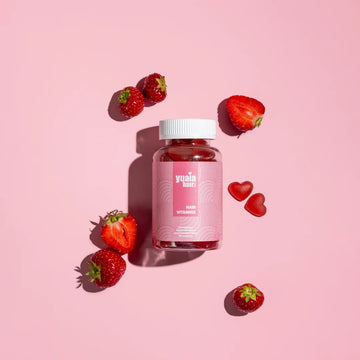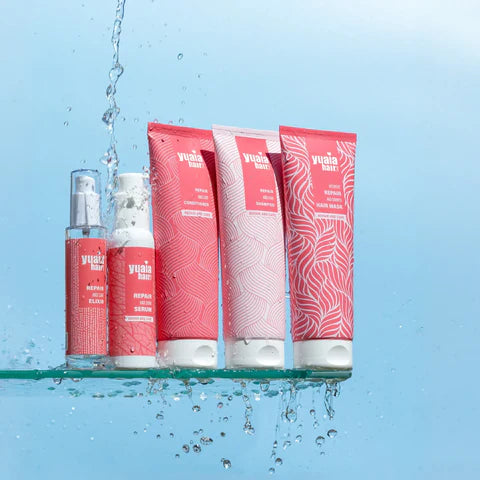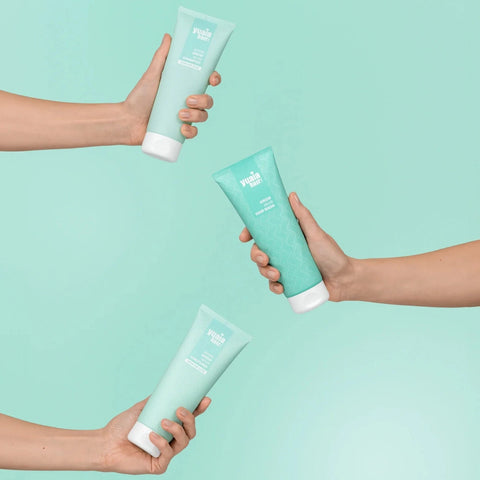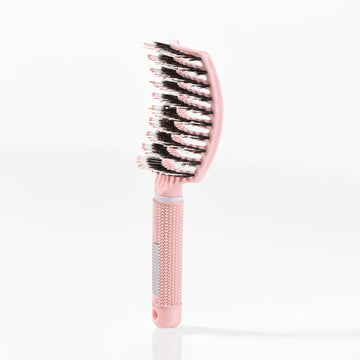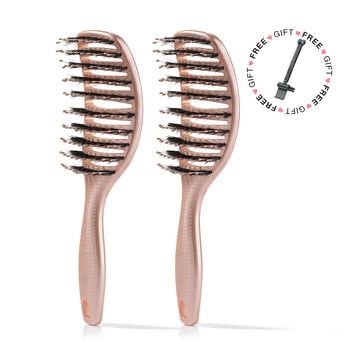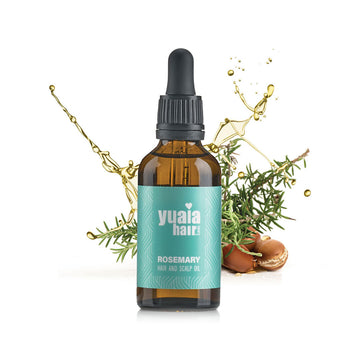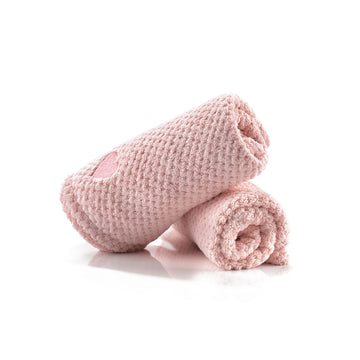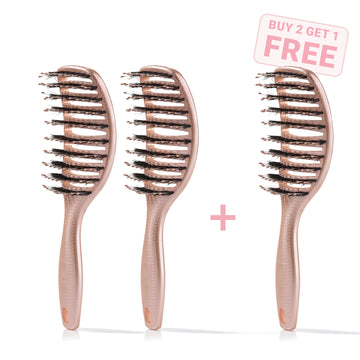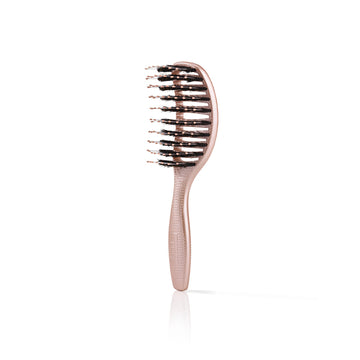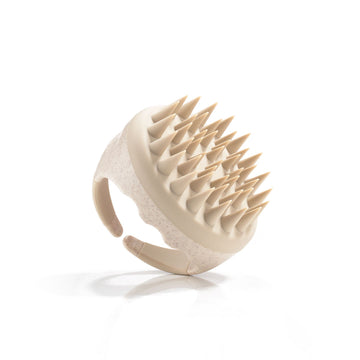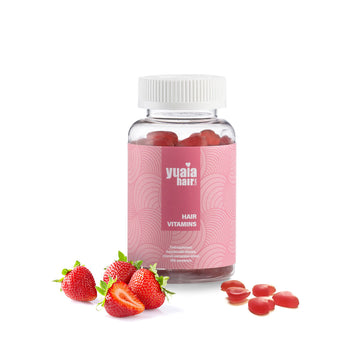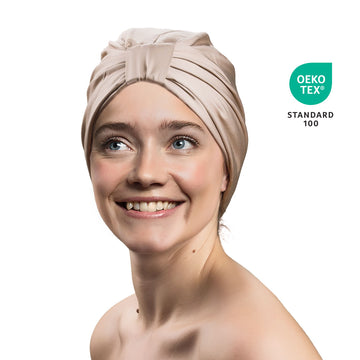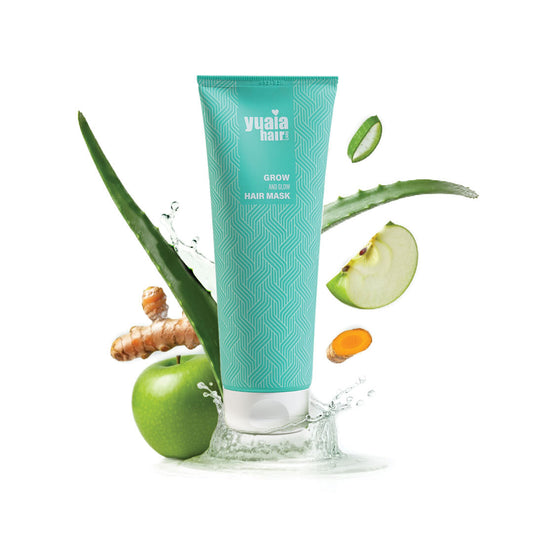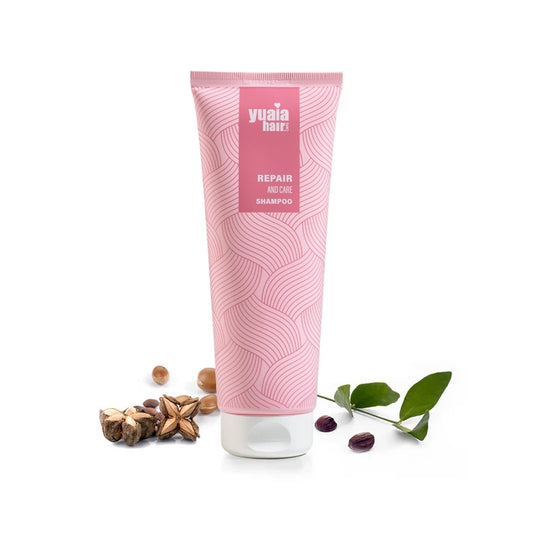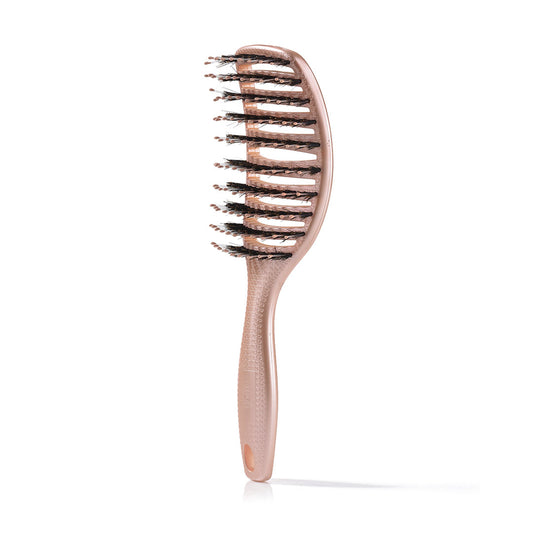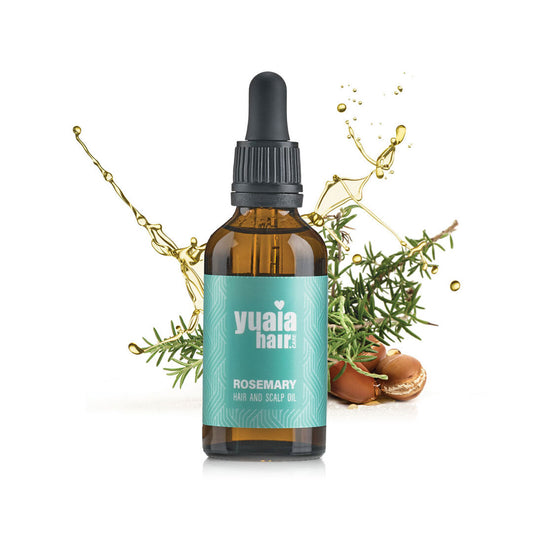How to take care of bleached hair: Our 8 best tips
When you bleach your hair, there is no doubt that you damage it. The bleaching process weakens the hair’s structure, leaving it prone to dryness, breakage, and split ends. Therefore, the aftercare of the hair is very important in terms of repairing and strengthening it afterwards. Especially if you are going through a course of bleaching, it is important that your aftercare is optimal, so that you ensure as strong hair as possible.
Skip washing your hair once in a while
Do you shower every day? Then you have to get used to skipping a few hair washes. Not only is your hair affected by the harsh treatment, your scalp can feel it too. That's why it's about giving your scalp a rest after your bleaching so that it recovers. You can do this by skipping the hair wash and when you finally wash your hair, give it a lot of moisture. By skipping a hair wash, the scalp gets the opportunity to produce its natural oils, which should help supply the hair with the necessary moisture.
In addition, it is good advice to wash your hair in as cold water as you can stand, as cold water dries out the hair much less than, for example, warm water.
Use a shampoo suitable for blonde hair
After bleaching, it is important that you get a shampoo that adds a lot of moisture to the hair and possibly a hair mask with some restorative proteins. However, it is especially important that you use a silver shampoo or shampoo targeted at blonde hair. When blonde and bleached hair is exposed to various substances, products and heat tools, it can have a tendency to take on a reddish or yellowish tinge. Silver shampoo contains a lot of purple pigment, which, if you observe the drying time, reduces the yellowish color that can occur in the hair. Read our guide to silver shampoo here .
NOTE: You should not use silver shampoo every time, as it is drying for the hair. It is therefore one of the last things you want to subject your bleached hair to. Here it is important that you use a moisturizing shampoo to alternate between. A nourishing shampoo enriched with ingredients like natural oils, proteins, or hyaluronic acid can restore hydration and improve the strength of your bleached hair.

Use an intensive hair treatment with plenty of moisture and keratin
This advice is probably one of the most important to remember when you bleach your hair. Your blonde, bleached hair needs a lot of moisture and restorative ingredients such as keratin and microproteins. It may be a good idea to use a hair conditioner often after the treatment, we recommend every other hair wash. However, this is very individual in relation to whether your hair tends to clump together with too much moisture. The hair treatment helps to give the hair the necessary moisture and care, which means that the hair strands do not break so easily.
It is important that after you have used the hair treatment, you finish with conditioner, as it helps to close the hair shaft again and thereby bind the moisture and care in the hair. This step is essential for locking in the nutrients and ensuring that the hydration stays within the hair fibers.
A small tip can be to leave the hair treatment in your hair for a longer period of time, for example you can watch a film, read a book while your hair gets care and moisture. Leaving the treatment in for an extended time allows the ingredients to penetrate deeper, providing maximum nourishment for bleached damaged hair.
Hair mask with keratin
Comb your hair through gently
A blonde, bleached hair is more porous than untreated hair. It may therefore be a good idea to find a good routine for combing your hair, possibly also find a gentle hair brush.
Here we can really recommend the Curved Paddle Brush, which with a combination of boar hair and nylon spikes gently combs through the hair. Boar bristles help distribute natural oils from the scalp down through the lengths, while nylon spikes detangle the hair without pulling or snapping the strands.
A good routine is to brush the hair when it is dry. Here you have to start from the ends and work your way up through the hair. You must never brush the hair with a hairbrush when it is wet. Your hair is very fragile after bleaching and only becomes extra fragile when the hair is wet.
Find a good moisturizing hair oil or leave-in product
You need a good leave-in hair oil or product if you have blonde bleached hair. You can give your hair a little extra love by finding a leave-in product that can both provide your hair with moisture and care, but at the same time also protect it from environmental influences.
We can recommend two products, our Hair Elixir, which is a hair oil with lots of moisture and care that gives a delicious shine and anti-frizz effect. If you are a bit more into a more restorative leave-in product, then our Repair and Care hair serum is something for you. It cares for the hair from the inside with Inca-Inchi oil, argan oil and wheat protein. These ingredients work together to strengthen damaged strands, improve elasticity, and protect against further breakage. In addition, it is also heat-protective and vegan.
Turn down the heat and styling
Many people use heat tools such as blow dryers, straighteners and curling irons in everyday life. No hair has good hair, especially not bleached hair which is more porous. By using heating tools, we make the hair hot in order to be able to style it in the desired way. But when the heat in the hair exceeds 215 degrees, the hair's protein keratin begins to melt. It will obviously not be good for the hair. Therefore, we recommend that you do not use heating tools that exceed 185 degrees heat.
With bleached hair, it is much more porous and therefore you need to go much further in heat before your hair is not damaged, try to limit yourself to 150 degrees if you finally have to use heat tools. Finally, it is also VERY important that you use a heat protection product in your hair before using the heat tools. In this way, your hair is best protected against the heat.
However, there may also be an idea in finding methods to style your hair without the use of heat. Here, it's just a search away on Youtube before you have endless inspiration for different ways to get curls or hairstyles.
Split ends: Trim them
After bleaching your hair, some of it may be included and lead to split ends. It is important to have your split ends cut regularly, as otherwise it can affect the rest of the hair, where it can either split or break. If split ends are left untreated, they can travel up the hair shaft, causing further damage and making the hair look uneven, dull, and unhealthy. If you notice split ends, it may therefore be a good idea to pay a short visit to your hairdresser.
Take care of your hair when it is wet
The hair is extra fragile when it is wet, especially if it is already fragile, it is important to pay extra attention. Water causes the hair cuticle to swell, making strands more elastic and prone to snapping under tension, particularly for bleached or chemically treated hair.
If you have to brush your hair while it is wet, it is important to use a wide-toothed comb to ensure as gentle detangling as possible. Start detangling from the ends and gradually work your way up to avoid pulling or creating further knots. This reduces tension on the hair strands, preventing unnecessary breakage and keeping your bleached hair healthier and more manageable.
The hair needs care, both external and internal care. External care is often talked about a lot, while internal care is often neglected. Nevertheless, it is almost as important, as it is important that the hair follicles produce as good hair strands as possible in order to maintain normal hair. Especially when you bleach your hair, it may be a good idea to supplement with a dietary supplement for the hair with biotin and zinc, which help to maintain normal hair. Here we can highly recommend our hair vitamins, which contain a lot of ingredients that have supporting functions to maintain normal hair.

What are the hidden dangers of DIY hair bleaching?
Are you considering bleaching your hair at home? While the idea of achieving salon-blonde locks yourself may seem tempting, there’s a hidden side to DIY bleaching. Does bleaching damage your hair? Yes, absolutely! Bleaching breaks down melanin, the pigment that gives hair its color. This process weakens the hair strands, making them more prone to damage.
Knowing your hair type is very important before bleaching. Bleaching affects different hair types in different ways. Fine hair is more susceptible to damage from bleach than thick, coarse hair. If you have curly or textured hair, bleaching can worsen frizz and make the hair unmanageable. Bleaching is not a one-size-fits-all solution. It’s essential to understand your hair's unique needs before proceeding.
Let’s explore the side effects of hair bleaching, especially if you choose DIY. We’ll also answer the question – does bleaching damage hair permanently?
Burns and scalp irritation
Bleaching products contain harsh chemicals like hydrogen peroxide. If not used correctly, these chemicals can cause scalp irritation, redness, and even burns. Scalp burns are painful and can lead to scarring. Bleaching at home increases the risk of these uncomfortable side effects. It can also damage the hair, leaving it dull and lifeless.
Hair breakage and split ends
Bleached hair loses its elasticity. This makes it dry, brittle, and prone to breakage. You may also experience excessive split ends. Brushing and styling bleached hair can be quite challenging as well. This is because bleach weakens the hair, and strands break easily. You need to be extra careful when styling bleached hair, but the focus should first be on restoring the damaged strands.
Uneven color and patchiness
Achieving an even blonde at home can be tricky. DIY bleaching can result in uneven shades, leaving patches of orange, yellow, or even darker hair. Patchy color looks unnatural, and you may need professional help to fix unevenly bleached hair. The entire process can also become expensive.
Chemical overprocessing and hair loss
Leaving bleach on your hair for too long can lead to overprocessing. This weakens the hair significantly and increases the risk of breakage. In the worst cases, it can even lead to hair loss. Severe overprocessing can sometimes cause permanent bald spots. If you’re wondering – does bleaching damage your hair permanently? The answer is that DIY bleaching mistakes can have long-term consequences for your hair’s health.
Difficulty in coloring bleached hair
Once your hair has been unevenly bleached, further coloring becomes a challenge. Unevenly bleached hair absorbs dye unevenly, often leading to unpredictable results. You may end up with dull, brassy tones! Achieving your desired hair color after bleaching requires expertise and care. So, we recommend avoiding DIY.
Are there alternatives to bleaching your hair at home?
Consider sun-kissed highlights or ombre coloring techniques instead of full bleaching. These methods use less bleach and are less damaging to your hair. You can also explore hair-lightening shampoos and conditioners, though their effects are milder. For a more subtle lightening effect, consider gentler alternatives that won’t compromise your hair’s health.
1. Professional help is always better
For a safe and successful hair-lightening treatment, visit a professional hairstylist. They will assess your hair’s health and recommend the right lightening technique. They will use high-quality products to minimize damage. Hairdressers have the knowledge and experience to achieve the desired look while keeping your hair healthy.
2. Taking care of bleached hair
If you must bleach your hair at home, prioritize aftercare. Invest in good-quality shampoo and conditioner for bleached hair. Deep conditioning treatments are essential to replenish moisture and prevent breakage. Regular trims are also important to remove split ends and maintain healthy hair. Bleached hair requires extra care to maintain its strength and shine.
Conclusion
Bleaching your hair at home can be tempting, but the risks are significant as it can damage the hair. Damaged hair takes time and effort to repair. Consider consulting a professional for a safer and more predictable hair-lightening experience. Bleached hair can look great, but achieving it without damage requires careful planning and expert care.
Frequently asked questions about bleaching the hair
How long does hair bleaching last?
Hair bleaching treatments typically last between 3-6 weeks before the results start to fade. This time frame can vary depending on the type of bleach used, the natural color of your hair, and the overall health and condition of your strands. Generally, lighter bleaching results tend to fade faster, especially if the hair isn’t cared for properly.
The longevity of bleaching also depends on the quality of the bleaching process and subsequent care. If the bleaching is done correctly and the hair is maintained with the right products, the results can last for several months. However, natural hair growth, frequent washing, and exposure to sunlight or environmental factors can gradually affect the color and cause unwanted fading, smearing, or changes in tone.
Repeated bleaching to achieve lighter shades can also impact durability, as repeated chemical processes degrade the hair's quality, making it more susceptible to damage. Fragile bleached hair requires consistent care to maintain its strength and brightness over time.
To maintain long-lasting results from a hair bleaching treatment, it is important to:
- Use high-quality products specifically designed for colored or bleached hair.
- Avoid frequent hair washing, as this accelerates fading.
- Limit the use of hot styling tools to prevent further damage.
- Protect your hair from the sun with products containing UV protection.
By following these tips and adopting a gentle care routine, you can extend the vibrancy of your bleached hair and keep it looking fresh and healthy for longer.
Can you lose hair by bleaching your hair?
Bleaching your hair can cause hair loss under certain circumstances. Firstly, the bleaching process itself can be very damaging to the hair strands as it requires harsh chemicals that strip the natural oils and pigments from the hair. This leads to dry and damaged hair that is more prone to breakage. In addition, if too much bleach is used or used incorrectly, it can burn or seriously damage your scalp, leading to irritation and temporary hair loss.
If you want to bleach your hair, it is best to go to a professional stylist who can apply the bleach correctly while being careful not to cause further damage.
To minimize potential damage, you should also use a sulfate-free shampoo and conditioner after bleaching. These gentler products help maintain moisture, strengthen the hair cuticle, and support recovery, reducing the risk of hair loss over time.
How harmful is bleaching of hair?
Bleaching hair is harmful due to the strong chemicals like ammonia and hydrogen peroxide, which break down the hair's natural pigment and damage the cuticle, the outer layer of the hair. This leads to dry, brittle hair, loss of shine and elasticity and increased porosity. Repeated bleaching can worsen the damage and lead to long-term problems like hair loss.

What is the difference between colouring and bleaching hair?
Hair colouring and hair bleaching are two different processes used to change the colour of hair, but they differ in their approach and mode of action:
- Hair colouring: Hair colouring involves adding colour pigment to the hair to change or enhance its colour. This can be done using permanent, semi-permanent or temporary hair colouring products. Colouring can darken, lighten or change the hair colour without removing the natural pigment.
- Hair bleaching: Hair bleaching involves removing the natural colour pigment from the hair using chemicals like ammonia and hydrogen peroxide. This process breaks down the hair's natural colour and makes it lighter or even completely blonde. Bleaching is necessary if you want to achieve lighter shades or to remove existing colour before applying a new colour.
In short, while colouring adds colour to the hair, bleaching removes the natural pigment to achieve a lighter colour. Both processes involve the use of chemicals, but bleaching is usually more damaging and requires more care to maintain the health and appearance of the hair.
How does bleaching affect different hair types?
Bleaching affects different hair types in different ways. Here's a brief guide to how the most common hair types react to bleaching and how you can best care for your hair after treatment.
Curly hair
Curly hair is often drier and more fragile than other hair types, making it more susceptible to damage from bleaching. The process can lead to loss of definition, increased frizz and breakage. To protect curly hair, it's important to use deep moisturising masks, such as coconut oil or shea butter, and avoid hot styling tools. Use a sulphate-free shampoo and a rich conditioner to retain moisture.
Thick hair
Thick hair can tolerate bleaching better than fine hair, but that doesn't mean it's completely free from damage. Bleaching can make thick hair coarse and lose its natural shine. It's important to use a moisturising shampoo and conditioner and regularly apply hair masks to maintain hair health. Products with ingredients such as argan oil and keratin can help rebuild and soften hair.
Fine hair
Fine hair is very sensitive to chemical treatments like bleaching. It can easily become weak and break. It's crucial to use protein supplements and gentle products specially formulated for fine hair to strengthen and protect it. Avoid excessive use of hot tools and consider using leave-in conditioners and lightweight oils for extra protection.
Get a 10% discount code sent to you
Receive the best tips and tricks for your hair from Lotte and Nanna 🥰
Product recommendations for bleached hair
Bleached hair requires a lot of moisture and care from your hair products, so it's essential that you choose the right products to avoid your hair breaking or becoming further damaged. Here are our top product recommendations
Get a complete conditioning and moisturising hair care kit
It's not enough to just change the shampoo in your attempt to care for your hair after bleaching, it requires more comprehensive care that you can easily get with our Healthy Hair Kit. It consists of a shampoo, conditioner and hair mask that provides maximum moisture, conditioning and strength to your hair.
The kit contains a wide range of ingredients such as Aloe Vera, Inca Inchi Oil, Macadamia Oil, Jojoba Oil and Shea Butter, Sorbitol, Sodium Hyaluronate (hyaluronic acid) which all have amazing conditioning properties. These ingredients work together to deeply hydrate, smooth, and protect fragile, bleached hair. In addition, it also contains hydrolysed wheat protein that works to rebuild and reduce damaged hair. This helps strengthen the hair’s structure, restoring elasticity and reducing the risk of further breakage.
The set also helps to reduce split ends and is of course colour protective. They're also sulphate and silicone free, so it's as gentle as possible on the hair.
An important tip is to use the shampoo twice and then use the hair mask for about 10 minutes before applying conditioner.
Heat protection with UV protection
A definite must have in your hair care routine when you have bleached your hair is to get a heat protection spray with UV protection. Heat and UV rays can be harsh on the hair and help to dry it out even more, which can lead to breakage. Bleached hair is particularly vulnerable to heat damage, as its structure is already weakened from the bleaching process, making it prone to dryness and frizz.
We highly recommend our Style and Shine Heat Protection Spray, which is heat-protective up to 220 degrees, UV protective and silicone-free. By forming a protective barrier around the strands, this spray shields your hair from both styling tools and environmental stressors, ensuring it stays strong and healthy. It also contains moisturising ingredients, so your hair stays moisturised even when exposed to heat.
Hair serum with heat protection
Our Repair and Care hair serum is great for conditioning and moisturising hair with its high content of fast-absorbing Inca Inchi Oil. It also contains hydrolysed wheat protein to help reduce damaged hair. It protects the hair and is also heat protective.
Microfibre hair towel
Hair is most fragile when it's wet. That's why it's a good idea to get a good microfibre hair towel that can ensure gentle and quick drying of the hair. Unlike traditional towels, microfibre reduces friction, which helps prevent breakage and frizz, making it ideal for fragile, bleached hair.
We highly recommend our microfibre hair towel, which is teddy bear soft and super water absorbent. Its high absorbency allows it to dry the hair faster while maintaining moisture, leaving your strands smoother and healthier. It sits well on the head and does not fall off easily. A sure winner with our customers.

 2-5 day delivery
2-5 day delivery
 25.000+ satisfied customers
25.000+ satisfied customers
 Satisfaction Guarantee
Satisfaction Guarantee

